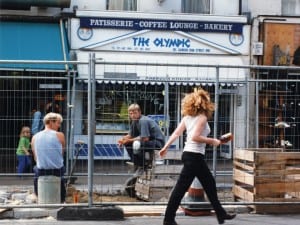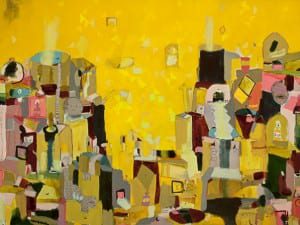Interview by Bethany Rex
Clare Price’s new work represents a departure from the strictures of her previous work. Whilst adhering to the familiar formalist rules of earlier paintings, starting with the hand rendered pixellated lines that form a grid for the work there is a new energy and freedom that is seen both in the leaving behind of her traditonal landscape format and also the breaking down of the relationship with the original drawing. We caught up with one of the directors, Charlie Dutton to find out what it takes to open your own gallery.
What was your background prior to opening the gallery?
I completed a Fine Art degree at Central St. Martins in 1996 and then was lucky to be able to consistently practice as an artist, working mainly in paint and photography. I also worked as an assistant to some really well known artists which provided me with some great opportunites and learning experiences! I always loved putting on exhibitions, not just my own but other peoples too. I naturally found hosting and promoting art thrilling and a valuable and meaningful part of the creative process. I’m not sure I can properly express how much I love art.
The gallery only opened in 2010, what’s your vision for the gallery?
It’s been a fantastic year and we have had some really amazing shows with brilliant artists- some mid career and some very much emerging. We’ve been feeling our way as we go and now it is operating as a new model of gallery – a cross between an ‘artist run project space’ and a commercial gallery. Everything at the Charlie Dutton Gallery is a collaboration and the direction of each show is shaped by the passion of the artists and the co-curators who have been involved. I feel like this reflects our geographical position in the heart of London, half- way between the commercial West End and the more ‘artist run’ East, so it feels natural. I hope the gallery can get more involved in some off- site projects too, and working with public spaces. I just want to be able to continue putting on amazing shows with amazing people, whatever forms they take, whist maintaining the critical visual language which the gallery has cultivated.
How do you find the artists you represent? What kind of relationship exists between you and the artist?
I don’t actually represent artists in the traditional sense and I don’t think I will for the foreseeable future, although if it felt right there’d be nothing to stop it happening. This is part of the collaborative approach I was talking about. If a show is right for the artist and the gallery we can make it happen together and do everything we can to promote it. After that if an artist wants to continue to build a relationship that’s fantastic- if something else comes along that’s best for them I fully support them in that too- but I always hope we’ll be able to come together again somewhere somehow! I’ve been a practicing artist and I think that is why I have such an excellent relationship with the artists and most importantly such a trusting one.
Are you excited to be working with Clare Price for the current show? How did your relationship come about?
I’ve known Clare for a while now, and I’ve always loved her work. The expressiveness and sort of cyber-punky nature is so electrifying. Price manages to produce an aesthetic that sits perfectly in todays technological world, while retaining and communicating very primary understandings of construct and feelings of beauty. She has observed a moment in time which belongs to every single one of us.
Coming from the world of moving image and directing, what impact do you think this has had on Price’s use of gesture?
I believe that Price’s use of gesture has its roots in her painting background as well as her love and obsession with 50s abstract painting (De Kooning, Joan Mitchell, late Patrick Heron) and in the contemporary sense people like Albert Oehlen and Christopher Wool. Her literal moving image and directing experience affects the work both in the carefully realised sense of composition, and more obtusely in her deeper and broader understandings of the image. The digital and emerging technologies that Price has encountered have had their effect too- the obsession with and use of pixels for example, and the wider themes of technological glitsches and digital drop out.
What are your aims for the gallery and what else does your programme hold in 2011?
Promoting great art is paramount. There are so many talented and passionate artists out there and I only wish I could show every single one. I believe that as long as the gallery sticks to its guns and doesn’t comprimise on quality and the high calibre of it’s visual language then I can continue to put on shows that I’m immensely proud of, and I can continue to show these shows to the gowing and diverse audience that I reach. The Open Salon show gives great exposure to the artists who enter. Nigel Grimmer, the winner from last year, is now working on a solo show for the Charlie Dutton Gallery in the Autumn. We have Simon Haddock next, then an exciting group show including Katrina Blannin, Andrew Bick and Marta Marce in the summer, followed up by a photography Salon and then it’s probably three more shows till the end of the year. It’s always busy. But mainly it’s always exciting and inspiring.
Digital Tenderness continues at Charlie Dutton Gallery, London until 30 April. For more information visit www.charlieduttongallery.com
Image: Gonna flight and tear it up in a hypernation for you 267x163cm
Courtesy the artist and Charlie Dutton gallery.





